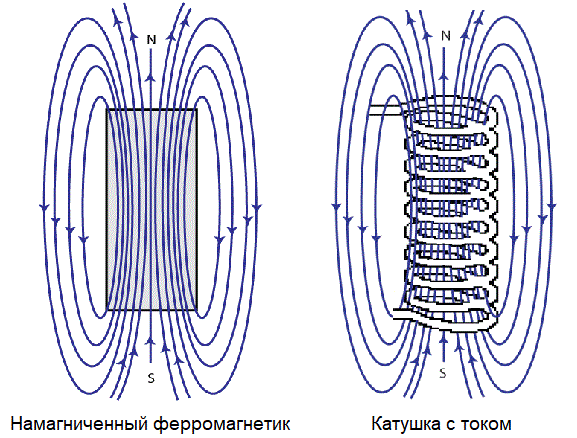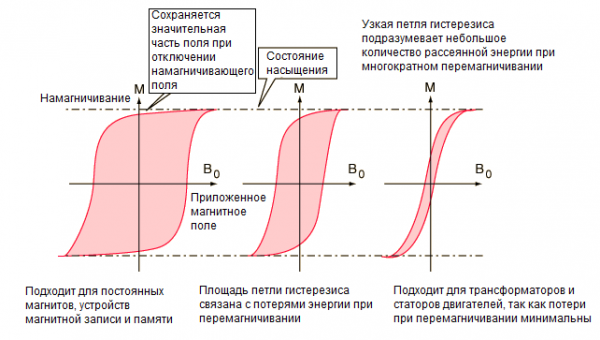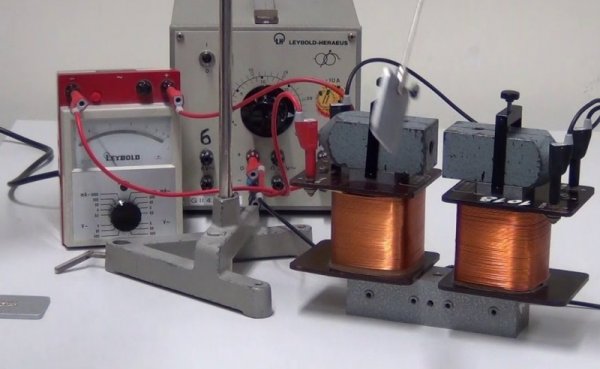Properties of ferromagnetic materials and their application in technology
Around a wire with an electric current, even in a vacuum, there is magnetic field… And if a substance is introduced into this field, then the magnetic field will change, since any substance in a magnetic field is magnetized, that is, it acquires a greater or lesser magnetic moment, defined as the sum of elementary magnetic moments associated with parts that make up that substance.
The essence of the phenomenon lies in the fact that the molecules of many substances have their own magnetic moments, because charges move inside the molecules, which form elementary circular currents and are therefore accompanied by magnetic fields. If no external magnetic field is applied to the substance, the magnetic moments of its molecules are randomly oriented in space, and the total magnetic field (as well as the total magnetic moment of the molecules) of such a sample will be zero.
If the sample is introduced into an external magnetic field, then the orientation of the elementary magnetic moments of its molecules will acquire a preferential direction under the influence of the external field. As a result, the total magnetic moment of the substance will no longer be zero, since the magnetic fields of individual molecules under new conditions do not compensate each other. Thus, the substance develops a magnetic field B.
If the molecules of a substance initially do not have magnetic moments (there are such substances), then when such a sample is introduced into a magnetic field, circular currents are induced in it, that is, the molecules acquire magnetic moments, which again, as a result, leads to the appearance of a total magnetic fields B.

Most of the known substances are weakly magnetized in a magnetic field, but there are also substances that are distinguished by strong magnetic properties, they are called ferromagnets… Examples of ferromagnets: iron, cobalt, nickel and their alloys.
Ferromagnets include solids that at low temperatures have a spontaneous (spontaneous) magnetization that varies significantly under the influence of an external magnetic field, mechanical deformation, or changing temperature. This is how steel and iron, nickel and cobalt and alloys behave. Their magnetic permeability is thousands of times higher than that of vacuum.
For this reason, in electrical engineering, to conduct magnetic flux and to convert energy, it is traditionally used magnetic cores made of ferromagnetic materials.
In such substances, the magnetic properties depend on the magnetic properties of the elementary carriers of magnetism — electrons moving inside atoms… Of course, electrons moving in orbits in atoms around their nuclei form circular currents (magnetic dipoles). But in this case, the electrons also rotate around their axes, creating spin magnetic moments, which simply play the main role in the magnetization of ferromagnets.
Ferromagnetic properties are manifested only when the substance is in a crystalline state. In addition, these properties are highly temperature dependent, as thermal motion prevents the stable orientation of the elementary magnetic moments. So, for each ferromagnet, a specific temperature (Curie point) is determined at which the magnetization structure is destroyed and the substance becomes a paramagnet. For example, for iron it is 900 ° C.
Even in weak magnetic fields, ferromagnets can be magnetized to saturation. Furthermore, their magnetic permeability depends on the magnitude of the applied external magnetic field.
At the beginning of the magnetization process magnetic induction B becomes stronger in a ferromagnetic, which means magnetic permeability it's great. But when saturation occurs, further increasing the magnetic induction of the external field no longer leads to an increase in the magnetic field of the ferromagnet, and therefore the magnetic permeability of the sample has decreased, now it tends to 1.
An important property of ferromagnets is remainder… Suppose a ferromagnetic rod is placed in the coil and by increasing the current in the coil it is brought into saturation. Then the current in the coil was turned off, that is, the magnetic field of the coil was removed.
It will be possible to notice that the rod is not demagnetized to the state in which it was at the beginning, its magnetic field will be greater, that is, there will be a residual induction. The rod was rotated in this way to a permanent magnet.
To demagnetize such a rod back, it will be necessary to apply to it an external magnetic field with the opposite direction and with an induction equal to the residual induction. The value of the modulus of magnetic field induction that must be applied to a magnetized ferromagnet (permanent magnet) in order to demagnetize it is called coercive force.

Magnetization curves (hysteresis loops) for different ferromagnetic materials differ from each other.
Some materials have wide hysteresis loops — these are materials with high residual magnetization, they are called magnetically hard materials. Hard magnetic materials are used in the manufacture of permanent magnets.
On the contrary, soft magnetic materials have a narrow hysteresis loop, low residual magnetization, and are easily magnetized in weak fields. These are soft magnetic materials that are used as magnetic cores of transformers, motor stators, etc.
Ferromagnets play a very important role in technology today. Soft magnetic materials (ferrites, electrical steel) are used in electric motors and generators, in transformers and chokes, as well as in radio engineering. Ferrites are made of inductor cores.
Hard magnetic materials (ferrites of barium, cobalt, strontium, neodymium-iron-boron) are used to make permanent magnets. Permanent magnets are widely used in electrical and acoustic instruments, in motors and generators, in magnetic compasses, etc.

